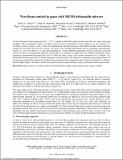Wavefront control in space with MEMS deformable mirrors
Author(s)
Cahoy, Kerri; Marinan, Anne D.; Novak, Benjamin G.; Kerr, Caitlin E.; Webber, Matthew William
DownloadCahoy_Wavefront control.pdf (2.073Mb)
PUBLISHER_POLICY
Publisher Policy
Article is made available in accordance with the publisher's policy and may be subject to US copyright law. Please refer to the publisher's site for terms of use.
Terms of use
Metadata
Show full item recordAbstract
To meet the high contrast requirement of 1 × 10[superscript −10] to image an Earth-like planet around a Sun-like star, space telescopes equipped with coronagraphs require wavefront control systems. Deformable mirrors (DMs) are a key element of a wavefront control system, as they correct for imperfections, thermal distortions, and diffraction that would otherwise corrupt the wavefront and ruin the contrast. The goal of the CubeSat Deformable Mirror technology demonstration mission is to test the ability of a microelectromechanical system (MEMS) deformable mirror to perform wavefront control on-orbit on a nanosatellite platform. In this paper, we consider two approaches for a MEMS deformable mirror technology demonstration payload that will fit within the mass, power, and volume constraints of a CubeSat: 1) a Michelson interferometer and 2) a Shack-Hartmann wavefront sensor. We clarify the constraints on the payload based on the resources required for supporting CubeSat subsystems drawn from subsystems that we have developed for a different CubeSat flight project. We discuss results from payload lab prototypes and their utility in defining mission requirements.
Date issued
2013-03Department
Massachusetts Institute of Technology. Department of Aeronautics and Astronautics; Massachusetts Institute of Technology. Department of Earth, Atmospheric, and Planetary SciencesJournal
Proceedings of SPIE--the International Society for Optical Engineering; v.8617
Publisher
SPIE
Citation
Cahoy, Kerri L., Anne D. Marinan, Benjamin Novak, Caitlin Kerr, and Matthew Webber. “Wavefront control in space with MEMS deformable mirrors.” In MEMS Adaptive Optics VII, edited by Scot S. Olivier, Thomas G. Bifano, and Joel Kubby, 861708-861708-16. SPIE - International Society for Optical Engineering, 2013. © (2013) COPYRIGHT Society of Photo-Optical Instrumentation Engineers (SPIE)
Version: Final published version
ISSN
0277-786X